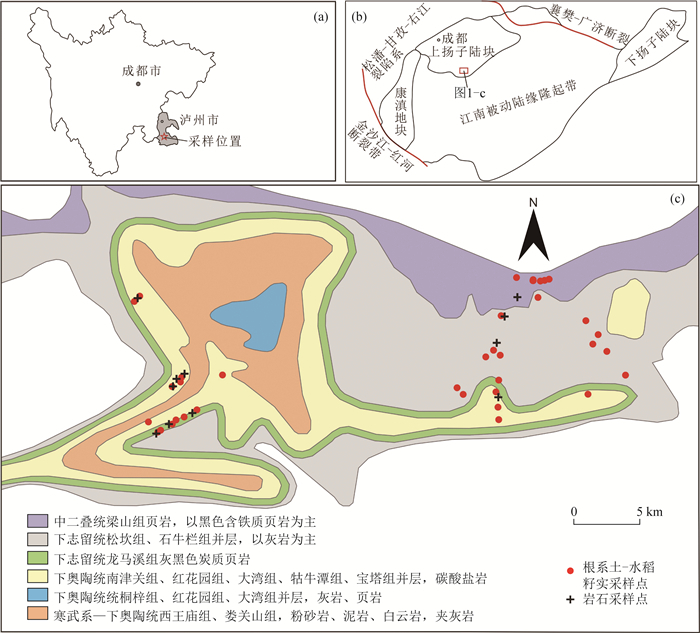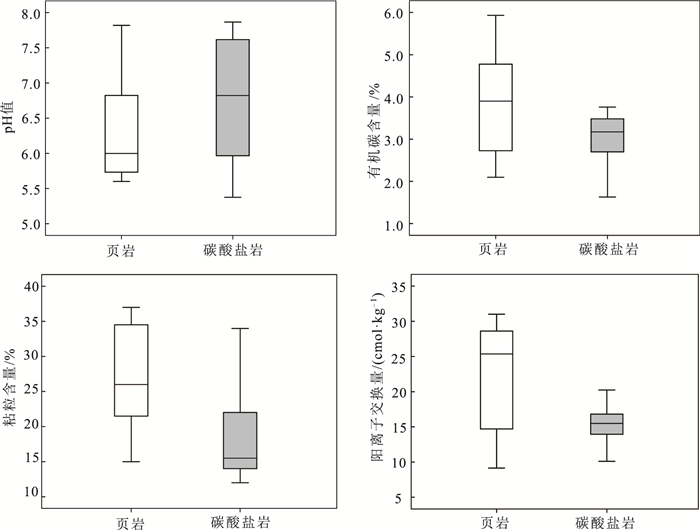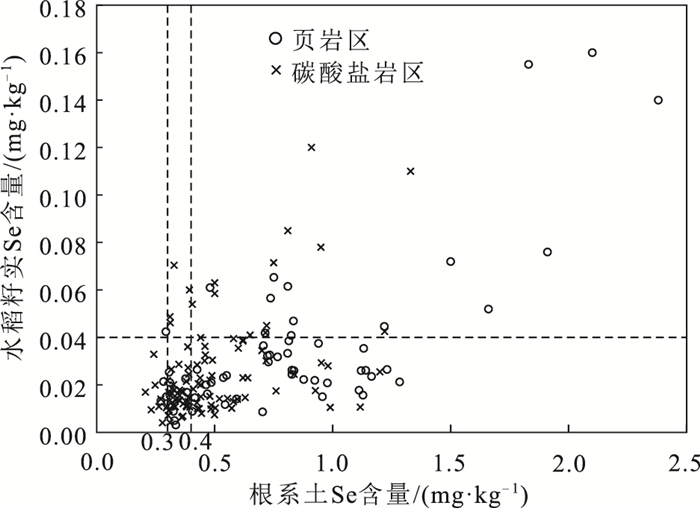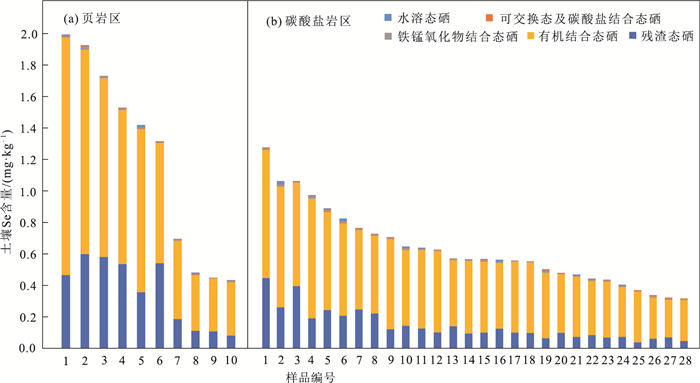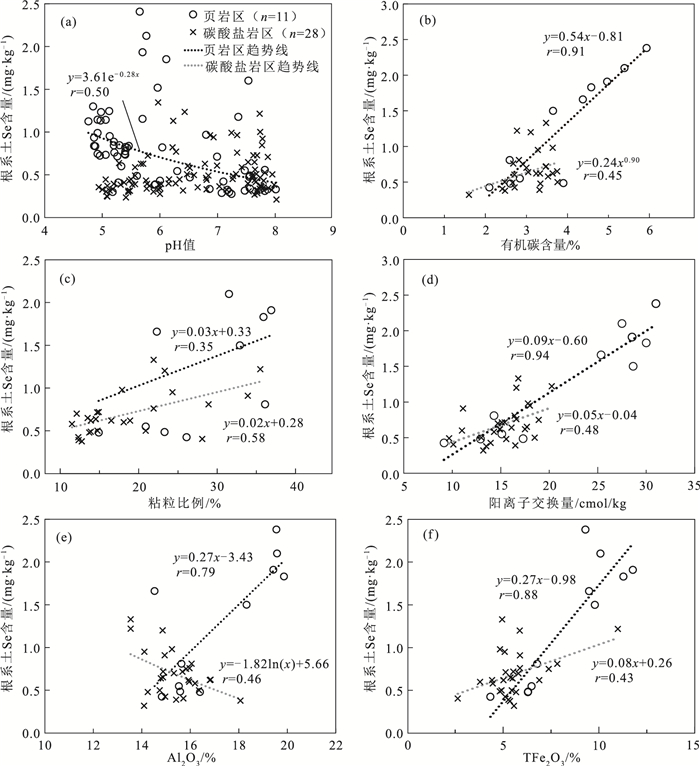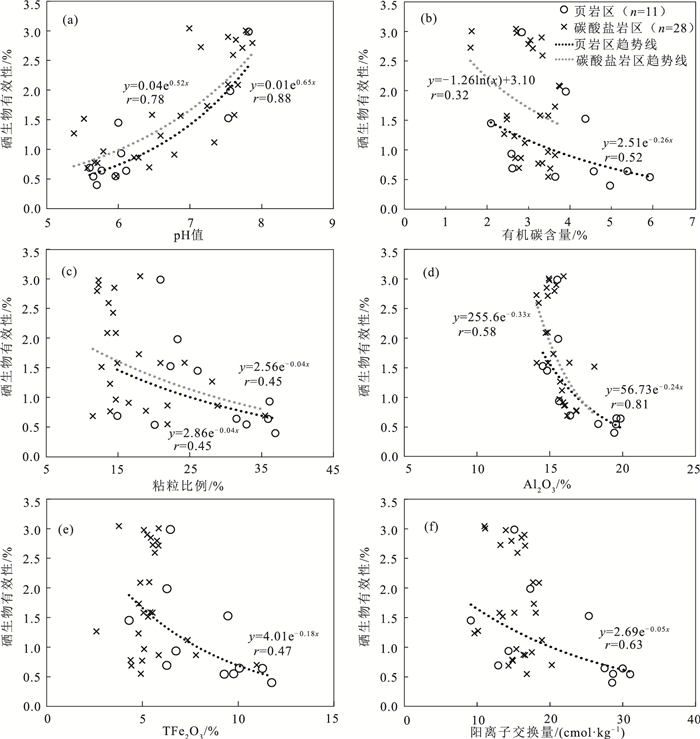Control factors of selenium content and bioavailability of rice root soil in shale and carbonate rock areas, Luzhou City, Sichuan Province
-
摘要:
以四川省泸州市碳酸盐岩和页岩分布区为研究区,开展了Se在成土母岩-根系土-水稻籽实体系中含量特征及迁移规律研究,丰富Se元素迁移转化理论,支撑服务富硒土地开发利用。研究结果表明,研究区页岩、根系土和水稻籽实Se含量分别为0.03~1.97 mg/kg、0.27~2.38 mg/kg和0.02~0.16 mg/kg,土壤硒以有机结合态(73%)和残渣态(25%)为主,有效态硒仅占0.69%。碳酸盐岩、根系土和水稻籽实Se含量分别为0.02~0.12 mg/kg、0.21~1.33 mg/kg和0.02~0.12 mg/kg,明显低于页岩区,土壤中有机结合态和残渣态硒所占比例高达97%,有效硒比例(1.58%)高于页岩区土壤。成土母岩的矿物组成和化学成分、Se含量及赋存形式对土壤性质和Se含量具有一定的控制作用。有机质、粘土矿物和pH值是土壤Se含量和生物有效性的主要控制因素。有机质和粘土矿物对硒的强烈吸附作用是研究区土壤富硒但生物有效性低的主要原因;pH值降低导致土壤胶体对硒的吸附能力升高,使土壤Se含量升高,但硒生物有效性随pH值降低明显降低。综上所述,研究区土壤Se含量高但生物有效性低,因此水稻籽实Se含量并不高,富硒土地的开发利用不能仅以土壤全Se含量作为判别标准,应结合土壤性质及硒生物有效性综合考虑。
Abstract:The control factors of selenium content and migration rule in the parent rock-root soil-rice system in sedimentary rock areas (carbonate rock and shale) were studied to enrich the theory of selenium migration and transformation and further support the scientific utilization of selenium-rich land.The Se values of shale, corresponding soil and rice seed are 0.03~1.97 mg/kg, 0.27~2.38 mg/kg and 0.02~0.16 mg/kg, respectively, and carbonate rock, soil and rice seed show Se content of 0.02~0.12 mg/kg, 0.21~1.33 mg/kg and 0.02~0.12 mg/kg.The proportion of organic binding Se and residual Se in soil is up to 98%.The Se bioavailability of soil in shale area is 0.69%, which is lower than that in carbonate rock area (1.58%).The mineral and chemical compositions as well as content and modes of occurrence of Se in parent rocks play an important role in controlling physicochemical properties and Se content in soils.The content and bioavailability of Se in soil are predominantly controlled by soil pH and colloids.The strong adsorption of Se by organic matter and clay minerals is the main factor responsible for high content but low bioavailability of Se in soils.The decrease of pH results in the increase of Se adsorption by soil colloids and thus high Se content in soil.However, Se bioavailability shows a decrease trend with pH decreases.In summary, the soils in shale and carbonate rock areas show high content but low bioavailability of Se and consequently, low Se content in rice seed.Therefore, the total Se content in soils could not be regarded as the criterion for the exploration of Se-rich soil, and the soil properties and Se bioavailability should also be cautiously considered.
-
Keywords:
- Se content in soil /
- bioavailability /
- shale /
- carbonate rocks /
- soil properties
-
早中新世后,随着青藏高原隆升,亚洲季风增强,中国北方大部地区逐渐脱离原有的行星气候控制的干旱气候状况,向今天的暖温带季风气候系统转变[1-2],其生态系统也由原来的草原及荒漠草原为主的植被景观,转变为森林草原-落叶阔叶林为主[2]。亚洲季风区的典型暖温带植被系统不仅对全球周期性气候变化具有明显的指示意义,而且对过去数百万年时间的气候转型具有较好的响应,因此,是近年来研究过去全球变化的重点[3-4]。
晚新近纪以来,全球气候经历了几次重要的调整过程,其中最重要的就是中更新世时期全球气候格局的调整,又称中更新世转型[5-6]。其特征为从“高频低幅”的早更新世气候向中更新世以来“低频高幅”的气候波动,其气候变化周期由40ka的地轴倾斜度周期,转变为100ka 的轨道偏心率周期[7]。期间全球气候降温,陆地表面大部分地区因此变得更加寒冷干燥,冰期时,形成北美、欧洲的冰盖,非洲撒哈拉沙漠形成,亚洲内陆环境进一步干旱化,冬季季风强度增加等[7-9]。研究中更新世气候格局的重新调整,以及转型前后气候周期性对华北地区植被的影响,有利于了解不同区域植被对全球气候环境变化的响应特征,为研究重大气候转型中的生态环境效应提供重要对比参照物[10]。
华北平原主要包括淮北平原、黄河平原和海河平原三大区块,位于中国北方地区的东部,属典型的季风区。华北平原北部海河下游地区的凹陷盆地中沉积了厚度大于5000m 的新生带地层[11],其中第四系厚280~410m,最厚约450m。目前,基于这些新生带地层,华北地区的古植被研究已有较多积累,如河北黄骅HB1、衡水HS1 及天津CQJ1 孔花粉谱[12-14],天津G2 孔[15]。但是由于地层中花粉鉴定数量偏少、地层年代学不完善,以及区域地貌、沉积环境等多元因素的影响,用高质量孢粉数据来探讨更新世以来华北地区植被转型与气候变化问题的研究并不多见。本次研究利用华北地区东部天津滨海新区沉积凹陷中G3 钻孔的岩心材料,通过古地磁年代序列及较高质量的孢粉分析数据重建区域植被历史,并结合已有的植被重建资料,探讨第四纪以来华北地区的植被演变特征及气候变化过程。
1. 研究区自然地理概况
位于北纬32°~40°、东经114°~121°的华北平原是中国东部最主要的平原,平均海拔低于50m,由黄河、海河、淮河等带来的泥沙沉积而成。华北平原属暖温带季风气候,四季变化明显,冬季寒冷、少雪;春季干旱,夏季气温高、湿度大、降水集中;全年平均气温8~15℃。年平均降水量南部淮河区800~1000mm,黄河下游600~700mm,海河下游为500~600mm,年降水量分配不平衡,多年平均水面蒸发量为1625mm,降水随季节变化显著,冬、春季少,夏季集中[16]。
研究区自然植被主要由暖温带落叶阔叶林组成。在现代植被中,阔叶类的落叶栎(Quercus)植被组成受纬向的温度效应控制非常明显,在南部为麻栎(Quercus acutissima)、栓皮栎(Quercus variabilis),向北逐渐过渡为蒙古栎(Quercus mongolica)和辽东栎(Quercus liaotungensis)。针叶类以松属(Pinus)占主要地位,以赤松(Pinus densiflora)为主。另外常见温带的枫桦(Betula costata)、五加(Eleutherococcussenticosus)、核桃楸(Juglans mandshurica Max.)、椴属(Tilia)等。华北平原,尤其是海河平原,湖泊和沼泽广布,沼泽植被以芦苇(Phragmites)、香蒲(Ty⁃pha)、水葱(Scirpus)、苔草(Carex)等为主[17]。
全新世晚期以来,由于人类活动的持续加强,华北地区原生落叶阔叶林遭到大规模破坏,形成了今天普遍的灌丛及灌丛草原,其中灌木以荆条、酸枣为主,草丛以黄背草和白羊草为建群种。
2. 研究材料与研究方法
2.1 钻孔地理位置与磁性地层
天津G3 钻孔(孔口坐标:北纬117°25′59.5″、东经38°49′57.6″)位于华北平原东部天津滨海地区的海河南侧,构造上属于黄骅坳陷中的板桥凹陷。孔口高程2.65m,孔深905m(图 1)。岩心直径100mm,全孔取心率90.0%以上。因此,取心率和岩心状况满足磁性地层学及其他研究的要求。
G3 孔200m 以上磁性地层中共有6 个极性段,包括3 个正极性段(N1~N3)和3 个负极性段(R1~R3),正极性段分别为N1(0~85.0m)、N2(95.5~105.9m)和N3(177~191.8m),负极性段分别为R1(85.0~95.5m)、R2(105.9~177.0m)和R3(191.8~212.5m)。其中N1(0~85.0m)以正极性为主,并且包含明显的全新世海相层,对应布容极性时(Brunhes),故确定N1(0~85.0m)对应C1n(0~0.781Ma)。85.0~212.5m(R1~R3)以负极性为主,对应松山极性时(Matuyama),其中,N2(95.5~105.9m)对应C1r.1n(0.988~1.072Ma),为贾拉米罗(Jaramillo)正极性亚时,奥尔都微(Olduvai)正极性亚时持续事件长,且强度大,在渤海湾沿岸其他钻孔中亦有出现,因此推断N3(177~191.8m)对应C2n(1.778~1.945Ma),为Olduvai正极性亚时(图 2)。
2.2 花粉分析方法
天津滨海新区大港G3 钻孔花粉样品取样深度在0~905m 之间,取样间隔岩性为粘土、亚粘土、亚砂土和砂。每个样品重量为100g,经盐酸和氢氟酸处理、直径7μm 筛网筛选提取花粉化石。花粉鉴定统计在400 倍日本OLYMPUS 光学生物显微镜下进行,每个样品鉴定统计的花粉数是观察统计3 个玻片以上得到的。
在取得的165 个样品的大部分中发现了花粉化石,但仅在160m 以上发现连续而丰富的花粉,160m以下花粉数量稀少,绝大多数样品中不足50 粒。160m 以上共42 个样品中花粉相对丰富,其中绝大多数样品鉴定粒数高于100 粒,样品平均粒数为218粒。本文选择具有连续有效花粉数据的0~160m 地层(0~1.7Ma),用Tilia 软件对花粉图谱进行百分比图谱的绘制(图 3)。
2.3 研究结果
在42 个有效样品中,共鉴定了9167 粒花粉,分属48 个科属。其中针叶乔木花粉有铁杉属(Tsu⁃ga)、冷杉属(Abies)、云杉属(Picea)和松属(Pinus),落叶阔叶乔木花粉有桦属(Betula)、鹅耳枥属(Car⁃pinus)、桤木属(Alnus)、栗属(Castanea)、落叶栎属(Quercus)、椴属(Tilia)、胡桃属(Juglans)、榆属(Ul⁃mus)、糙叶树属(Aphananthe)、枫香属(Liquidanber)、山核桃属(Carya)、无患子科(Sapindaceae),灌木植物花粉有嚼床科(Acanthaceae)、胡秃子科(Elaeagna⁃ceae)、榛属(Corylus)、虎榛子属(Ostryopsis)、麻黄属(Ephedra)、忍冬科(Caprifoliaceae)、蔷薇科(Rosace⁃ae)。草本植物花粉有旱生的地榆属(Sangnisorba)、葎草属(Humulus)、藜科(Chenopodiaceae)、菊科(Compositea)、蒿属(Artemisia)、茜草科(Rubiace⁃ae)、唇形科(Labiatea)、豆科(Leguminosae)、茄科(Solanaceae)、蓼属(Polygonum)、十字花科(Crcife⁃rae)、石竹科(Caryophllaceae)、伞形花科(Umbella⁃les)等,水生植物有禾本科(Gramineae)、泽泻科(Alismataceae)、香蒲属(Typha)、莎草科(Cyperace⁃ae)、荇菜属(Nymphoides)。蕨类植物孢子有石松科(Lycopodiaceae)、水龙骨属(Polypodium)、凤尾蕨属(Pteridium)、卷柏属(Selaginella)、水蕨科(Parkeria⁃ceae)、单缝孢子(Monolites)和三缝孢子(Trilites)。
通过Canoco 4.5 软件对G3 孔中孢粉属种排序(图 4),发现所有属种可分为4 个类群:①以云杉、松为代表的温性针叶林;②以栎属、榛属、栗属、胡桃等为主的落叶阔叶林;③以蒿属、藜科、禾本科和桦属为主的草原及疏林草原;④以榆属、蔷薇科、胡颓子和铁杉为主的暖温性灌丛。根据属种的分布规律推断,图 4 中第一主轴(横轴)指示湿度,第二主轴(纵轴)指示温度。
如图 3 所示,根据孢粉聚类分析结果,将G3 孔中花粉百分比图谱分为4 个带。
(1)孢粉带Ⅰ:松属-云杉属-藜属-菊科-蕨类组合(1.6~1.2Ma)
乔木平均为58.6%,以松(12.7%~84.2%)和云杉(0~10.6%)为主,早期有少量铁杉,后过渡为云杉,此外还包含含量较低的栎属、榆属、椴属、桦属、胡桃属等常见暖温性阔叶乔木;草本中藜科最多,平均为8.1%,菊科含量平均4.3%,最高14.3%,蒿属含量少于菊科,平均仅2.8%。蕨类孢子在本带含量较丰富,以石松为主,另外还有水龙骨、凤尾蕨等蕨类。
本段组合指示暖温带针阔叶混交林的特点,其中松属为主要建群种,其花粉的突出代表性使松属在此时具有绝对优势。其中重要的变化在1.5Ma 前后,针叶林成分由铁杉向云杉转变的过程,显示一次降温事件,由此又可以划分出2 个阶段,即Ⅰ -1(1.6~1.5Ma)和Ⅰ -2(1.5~1.2Ma)。草本组合显示,1.5Ma 以前,菊科含量较高,而到后期,禾本科含量逐渐增加,菊科花粉基本消失,显示了区域草地环境由湿转干的过程。
(2)孢粉带Ⅱ:松属-栎属-藜-蒿组合(1.2~0.7Ma)
本段乔木花粉整体比例下降,松属比例由上段的平均51%下降至15%左右,云杉、铁杉等针叶树基本消失,但落叶栎属比例由带Ⅰ的1.2%,显著上升为13.0%,同时桦属花粉也显著增加,另有少量栗属、榆属、胡桃属等阔叶树。草本花粉组成也发生重要改变,藜科、蒿属比例大幅度增加,并伴随禾本科与香蒲属花粉的增加。蒿属平均值由原来的2.7%增加为20.7%。
本段孢粉组合指示暖温带落叶阔叶林的植被特征。草本花粉,尤其是蒿属的比例大幅度增加,显示华北地区在该阶段林地消退与草原发展,指示该时期气候干旱化。
(3)孢粉带Ⅲ:栎属-松属-藜-蒿-香蒲组合(0.7~0.3Ma)
本段乔木花粉比例最低,松属平均值由15%进一步下降,栎属略有下降,伴随较多的桦属与少量云杉属、铁杉属,并出现了零星的枫香属、山核桃属花粉。草本中藜科和蒿属依然占据主导地位,显示草原继续发展,而香蒲比例大幅度上升,显示周边地区湖泊湿地的扩展。本段孢粉组合指示疏林草原的植被景观,同时,湖泊湿地开始大规模发育。
(4)孢粉带Ⅳ:松属-栎属-藜-蒿-香蒲组合(0.3~0Ma)
本段针叶乔木花粉比例回升,松属增加至22.1%,云杉、铁杉花粉含量也有显著增加,而阔叶类乔木比例下降,栎属略微下降,枫香属、山核桃属消失,出现少量椴属、栗属、榆属、胡桃属等阔叶树。草本主要变化为藜科比例下降和香蒲比例升高。本段孢粉组合指示以暖温带落叶阔叶林为主的植被景观,湖泊湿地持续发育。
3. 讨论
3.1 演变趋势
中更新世气候转型期间,全球冰量整体增加了约15%,平均温度显著下降。对于其转型时间,大部分研究显示其大约开始于1.2Ma[6],另一些研究认为稍晚,在约1.05Ma,或是0.9Ma 前后,另外有人认为这种转型也可能是以一种渐进的方式进行的,始于1.2Ma,到约0.6Ma 才完成转型[18]。
G3 孔指示的中国华北平原地区中更新世植被转型期,对应上述的孢粉带Ⅱ,显示华北地区植被转型开始发生于1.2Ma,主要表现为林地减少,喜湿的针叶林比例下降,较为干旱的落叶阔叶林增加,同时藜科、蒿属、禾本科等草地面积显著增加。这种变化在1.2Ma 左右的某个时间点发生,大致相当于深海O 同位素36 阶段。
黄骅HB1、衡水HS1、天津CQJ2 孔、天津G2 孔的1.28~2.80Ma 为暖温带落叶阔叶林的景观,整体上较暖湿。1.28Ma以来,典型暖温带阔叶乔木花粉比例减小,华北平原草地扩张,而黄骅HB1 孔与衡水HS1 孔在中更新世前后也发生了类似事件[12-15]。
尽管由于孢粉数据分辨率的问题,所有这些钻孔的花粉百分比变化在时间上没有完好吻合,但是1.2Ma 前后,中更新世转型期推动华北平原地区植被整体向干旱类型发展是具有普遍性的。
此后,大约在0.7Ma 前后又发生一次重大转型,林地进一步退化,区域植被由原来的落叶阔叶林向疏林草原转变,对应深海O 同位素18 阶段。之后这种趋势一直延续到0.3Ma 左右才发生转变。黄骅HB1 孔中,0.8~0.7Ma 以后以蒿属和香蒲属为主,草本花粉出现,并分别达到12.5% 和10.9%,衡水HS1孔中以蒿和藜科为代表的草本花粉在0.78Ma 后也显著增长,显示华北平原0.7~0.8Ma 前后草地植被显著扩张[12-14]。此后,在约0.3Ma,即大约O 同位素8 阶段以后,华北地区植被中林地比例再度增加,可能与深海O 同位素11 阶段以后的7 阶段,5 阶段等几次典型的高温期有关。
3.2 周期性气候变化的区域植被响应
尽管由于样品分辨率的问题,周期性气候变化导致的区域植被变化未能完全被花粉谱记录,以致花粉谱更多地指示了区域植被在万年尺度的长期发展趋势。但是,不论是1.2Ma 之前的40ka 轨道倾斜度周期性,还是1.2Ma 之后的100ka 轨道偏心率周期,周期性气候变化对植被的影响,在花粉谱中确有一定表现。
例如在孢粉带Ⅰ中,以松为代表的乔木花粉比例的波动变化为10%~80%,可能对应该时期由地轴倾斜度40ka 周期变化导致的区域植被的变化。在带Ⅳ 也有类似的波动响应。由此可见,不论是1.2Ma 之前40ka 周期的“ 高频低幅”变化,还是1.2Ma 之后,100ka 周期的“低频高幅”变化,对华北地区的植被都有显著影响。
如图 3 所示,华北地区植被在1.6~1.2Ma 期间在40ka 气候周期“高频低幅”的变化中,主要表现为松属、常绿栎、铁杉属、胡桃属的交替变化,指示了区域暖温性与温性植被林地类型的交替变化。而1.2Ma 之后随着草原植被的扩张,100ka 周期的“低频高幅”变化造成的华北地区区域植被的响应更多地表现为草原与森林的交替发展。
4. 结论
华北平原东北部天津G3 孔孢粉数据及周边地区已有花粉研究表明,华北平原地区1.6Ma 以来的植被演化主要可以分为4 个阶段:①1.6~1.2Ma 密闭度较高的暖温带针阔叶混交林;②1.2~0.7Ma 开阔的暖温带落叶阔叶林;③0.7~0.3Ma,阔叶疏林草原;④0.3Ma 至今,暖温带落叶阔叶林。
中国华北平原地区中更新世植被转型期对应于孢粉带Ⅱ,显示该转型始于1.2Ma,大致对应深海O 同位素36 阶段。主要特征为林地减少、喜湿的针叶林比例下降,较为干旱的落叶阔叶林增加,同时,藜科、蒿属、禾本科等草地面积显著增加。
大约在0.7Ma 前后又发生一次重大转型,林地进一步退化,区域植被由原来的落叶阔叶林向疏林草原转变,对应深海O 同位素18 阶段。
G3 孔代表的花粉谱显示,1.6Ma 以来气候周期性的变化对华北地区区域植被有较显著的影响。
在1.2Ma 之前,受40ka 轨道倾斜度气候周期性的影响,主要表现为植被林地类型的交替发展;在1.2Ma之后,受100ka 轨道偏心率气候周期性影响,主要表现为草原与森林交替发展。
-
表 1 页岩和碳酸盐岩氧化物、有机碳及Se含量
Table 1 The content of oxides, organic carbon and selenium in shale and carbonate rock
岩石类型 SiO2 Al2O3 TFe2O3 MgO CaO Na2O K2O Corg Se 页岩 66.02 11.65 3.13 2.21 6.58 0.29 3.07 4.18 1.36 72.37 13.02 3.88 1.53 0.58 0.39 3.68 2.91 1.97 62.52 15.35 4.14 1.75 4.91 1.43 3.61 0.35 0.90 55.06 15.82 5.31 3.19 9.80 0.56 3.80 0.95 0.27 69.68 13.24 9.95 0.97 0.32 0.13 3.56 0.18 0.09 68.11 12.82 3.31 0.82 0.99 2.27 4.45 0.09 0.03 碳酸盐岩 8.13 2.94 0.91 0.58 49.29 0.08 0.59 0.10 0.03 7.62 2.55 0.93 0.53 49.47 0.09 0.50 0.04 0.02 4.27 0.50 0.39 0.72 53.31 0.07 0.07 0.22 0.12 11.71 3.70 1.02 7.56 39.09 0.10 1.01 0.42 0.05 注:氧化物和有机质含量单位为%,Se含量单位为mg/kg 表 2 页岩区和碳酸盐岩区土壤氧化物含量
Table 2 The statistical summary of oxides in soils derived from shale and carbonate rock
成土母岩 氧化物 最大值/% 最小值/% 平均值/% 中值/% 标准差 页岩区
(n=11)SiO2 68.30 48.91 57.65 56.36 6.73 Al2O3 19.86 14.52 17.20 16.39 2.14 TFe2O3 11.75 4.31 8.33 9.28 2.41 MgO 1.87 0.42 1.03 0.98 0.56 CaO 3.24 0.33 1.26 0.92 0.95 Na2O 1.24 0.24 0.50 0.42 0.28 K2O 3.42 0.83 2.12 1.66 1.06 碳酸盐岩区
(n=28)SiO2 70.12 58.24 63.85 63.72 3.10 Al2O3 18.06 11.85 15.24 15.28 1.22 TFe2O3 10.97 2.60 5.52 5.33 1.46 MgO 2.49 0.84 1.41 1.47 0.34 CaO 6.67 0.23 1.99 1.05 1.92 Na2O 0.65 0.15 0.34 0.36 0.14 K2O 4.29 1.40 3.15 3.19 0.56 -
李娟.生命微量元素硒环境营养背景研究——以贵州开阳县为例[D].贵州师范大学硕士学位论文, 2000. 姚远溪, 顾艳耿, 吕蒙, 等.富硒蔬菜和谷物与人体健康分析[J].农产品加工, 2018, 12:80-82. https://www.cnki.com.cn/Article/CJFDTOTAL-NCPJ201824025.htm Cao Z H, Wang X C, Yao D H, et al Selenium geochemistry of paddy soils in Yangtze River Delta[J].Environmental International, 2001, 26:335-339. doi: 10.1016/S0160-4120(01)00009-5
Wang Z, Gao Y.Biogeochemical cycling of selenium in Chinese environments[J].Applied Geochemistry, 2001, 16:1345-1351. doi: 10.1016/S0883-2927(01)00046-4
孙朝, 侯青叶, 杨忠芳, 等.典型土壤环境中硒的迁移转化影响因素研究——以四川省成都经济区为例[J].中国地质, 2010, 37(6):1760-1768. doi: 10.3969/j.issn.1000-3657.2010.06.023 王锐, 余涛, 杨忠芳.富硒土壤硒生物有效性及影响因素研究[J].长江流域资源与环境, 2018, 27(7):1647-1654. https://www.cnki.com.cn/Article/CJFDTOTAL-CJLY201807024.htm Antanaitis A, Lubyte J, Antanaitis S, et al.Selenium concentration dependence on soil properties[J].Journal of Food Agriculture and Environment, 2008, 6:163. http://www.researchgate.net/publication/267405569_selenium_concentration_dependence_on_soil_properties
Xing K, Zhou S, Wu X, et al.Concentrations and characteristics of selenium in soil samples from Dashan region, a selenium enriched area in China[J].Soil Science and Plant Nutrition, 2015, 61:889-897. doi: 10.1080/00380768.2015.1075363
李杰, 杨志强, 刘枝刚, 等.南宁市土壤硒分布特征及其影响因素探讨[J].土壤学报, 2012, (5):1012-1020. https://www.cnki.com.cn/Article/CJFDTOTAL-TRXB201205021.htm 田欢.典型富硒区岩石-土壤-植物中硒的赋存状态及环境行为研究[D].中国地质大学博士学位论文, 2017. 倪师军, 张成江, 徐争启, 等.四川万源地区硒的地球化学特征[J].矿物岩石, 2007, 27(4):39-44. doi: 10.3969/j.issn.1001-6872.2007.04.007 Wilson M J.The importance of parent material in soil classification:A review in ahistorical context[J].Catena, 2019, 182:1-7. http://www.sciencedirect.com/science/article/pii/S0341816219302735
Song T J, Cui G, Su X S, et al.The origin of soil selenium in a typical agricultural area in Hamatong River Basin, Sanjiang Plain, China[J].Catena, 2020, 185:1-9. http://www.sciencedirect.com/science/article/pii/S0341816219304977
Zhong S Q, Wei C F, Ni J P, et al.Characterization of clay rock-derived soils containing multi-mineral sandparticles in upland areas of Sichuan Basin, China[J].Catena, 2020, 194:1-13. http://www.sciencedirect.com/science/article/pii/S0341816220302873
Kulp T R, Pratt L M.Speciation and Weathering of Selenium in Upper Cretaceous Chalk and Shale from South Dakota and Wyoming, USA[J].Geochimca et Cosmochimica Acta, 2004, 68:3687-3701. doi: 10.1016/j.gca.2004.03.008
Matamoros A, Newton R J, Benning L G.What Controls Selenium Release during Shale Weathering?[J].Applied Geochemistry, 2011, 26:222-226. doi: 10.1016/j.apgeochem.2010.11.022
Zhu J M, Han W L, Lei L, et al.Selenium Speciation of Se-rich Rocks from Yutangba of Enshi, China[J].Geochimica et Cosmochimica Acta, 2006, 70(18 Suppl.):26. http://www.sciencedirect.com/science/article/pii/S0016703706018187
Matamoros A, Benning L G.Selenium in shales:where is it?[J].Geochimica et Cosmochimica Acta, 2010, 74(11 Suppl.):677.
Yan M C, Chi Q H.The chemical composition of the continental crust and rocks in the eastern part of China[M].Beijing:Science Press, 2005:1-171.
张更.上扬子板块陡山沱组黑色页岩硒的地球化学[D].贵州大学硕士学位论文, 2006. 朱立军, 李景阳.碳酸盐岩风化成土作用及其环境效应[J].北京:地质出版社, 2004:1-131. https://cdmd.cnki.com.cn/Article/CDMD-10657-2010070299.htm 王世杰, 孙承兴, 冯志刚, 等.发育完整的灰岩风化壳及其矿物学与地球化学特征[J].矿物学报, 2002, 22(1):19-29. doi: 10.3321/j.issn:1000-4734.2002.01.004 中华人民共和国国土资源部.多目标区域地球化学调查规范(1:250000)(DZ/T 0258-2014)[M].北京:中国标准出版社, 2014. 中国地质调查局.生态地球化学评价样品分析技术要求(DD 2005-03)[S].北京: 中国地质调查局, 2005. 中国地质调查局..天然富硒土地划定与标识(DD 2019-10[S].北京: 中国地质调查局, 2019. 中华人民共和国国家质量监督检验检疫总局, 中国国家标准化管理委员会.富硒稻谷(GB/T 22499-2008)[M].北京:中国标准出版社, 2008. 陈开惠.湖北均县风化型高岭土中蒙脱石矿物的形成和变化[J].地质科学, 1981, 4:384-390. https://www.cnki.com.cn/Article/CJFDTOTAL-DZKX198104010.htm 王彦华, 谢先德, 罗立峰.花岗岩中黑云母风化的矿物变化机制[J].地球化学, 1999, 28(3):239-247. doi: 10.3321/j.issn:0379-1726.1999.03.005 李福春, 李莎, 杨用钊, 等.原生硅酸盐矿物风化产物的研究进展:以云母和长石为例[J].岩石矿物学杂志, 2006, 25(5):440-448. doi: 10.3969/j.issn.1000-6524.2006.05.008 Berner R A, Holdren G R.Mechanism of feldspar weathering:some observational evidence[J].Geology, 1977, 5(6):369. doi: 10.1130/0091-7613(1977)5<369:MOFWSO>2.0.CO;2
莫彬彬, 连宾.长石风化作用及影响因素分析[J].地学前缘, 2010, 17(3):281-289. https://www.cnki.com.cn/Article/CJFDTOTAL-DXQY201003033.htm Lützow M, Kögel-Knabner I, Ekschmitt K, et al.Stabilization of organic matter in temperate soils:Mechanisms and their relevance under diferent soil conditions-A review[J].European Journal of Soil Science, 2006, 57:426-445. doi: 10.1111/j.1365-2389.2006.00809.x
Greiner E, Kumar K, Sumit M, et al.Adsorption of L-glutamic acid and L-aspartic acid to γ-Al2O3[J].Geochimica et Cosmochimica Acta, 2014, 133:142-155. doi: 10.1016/j.gca.2014.01.004
万丹.铁氧化物和钙离子对土壤有机碳的固定及有机质对Pb形态转化的影响[D].华中农业大学博士学位论文, 2019. 孙承运.不同温湿度条件下土壤有机质和秸秆分解规律与模拟[D].中国农业大学硕士学位论文, 2004. 苌伟.气温与土壤湿度对祁连山北坡植物种子萌发和土壤有机质分解的影响研究[D].北京林业大学硕士学位论文, 2007. Doetterl S, Stevens A, Six J, et al.Soil carbon storage controlledby interactions between geochemistry and climate[J].Nature Geoscience, 2015, 8:780-783. doi: 10.1038/ngeo2516
Bai Y X, Zhou Y C.The main factors controlling spatial variability of soil organic carbon in a small karst watershed, Guizhou Province, China[J].Geoderma, 2020, 357:1-12. http://www.sciencedirect.com/science/article/pii/S0016706119308432
安永龙, 黄勇, 张艳玲, 等.北京房山南部地区富硒土壤生物有效性特征及来源[J].地质通报, 2020, 39(2/3):387-399. http://dzhtb.cgs.cn/gbc/ch/reader/view_abstract.aspx?file_no=2020020319&flag=1 郭宇, 鲍征宇, 马真真, 等.湖北恩施地区土壤-植物系统中Se元素的地球化学特征[J].地质通报, 2012, 31(1):151-155. doi: 10.3969/j.issn.1671-2552.2012.01.019 刘子宁, 窦磊, 游远航.珠江三角洲台山地区硒的地球化学特征[J].现代地质, 2014, 28(5):928-934. doi: 10.3969/j.issn.1000-8527.2014.05.006 Spadoni M, Voltaggio M, Carcea M, et al.Bioaccessible selenium in Italian agricultural soils:comparison of the biogeochemical approach with a regression model based on geochemical and pedoclimatic variables[J].Science of the Total Environment, 2007, 376:160-177. doi: 10.1016/j.scitotenv.2007.01.066
Mehdi Y, Hornick J L, Istasse L, et al.Selenium in the environment, metabolism and involvement in body functions[J].Molecules, 2013, 18:3292-3311. doi: 10.3390/molecules18033292
Bujdos M, Mulova A, Kubova J, et al.Selenium Fractionation and Speciation in Rocks, Soils, Waters and Plants in Polluted Surface Mine Environment[J].Environmental Geology, 2005, 47:353-360. doi: 10.1007/s00254-004-1157-2
Floor G H, Roman-Ross G.Selenium in Volcanic Environments:A Review[J].Applied Geochemistry, 2012, 27:517-531. doi: 10.1016/j.apgeochem.2011.11.010
Zeng C, Ramos-Ruiz A, Field J A, et al.Cadmium Telluride(CdTe)and Cadmium Selenide(CdSe)Leaching Behavior and Surface Chemistry in Response to pH and O2[J].Journal of Environmental Management, 2015, 154:78-85. http://europepmc.org/abstract/med/25710599
王云, 魏复盛.土壤环境化学元素[M].北京:中国环境科学出版社, 1995:1-230. Masscheleyn P H, Delaune R D, Patrick W H.Transformations of selenium as affected by sediment oxidation-reduction potential and pH[J].Journal of Environmental Quality, 1990, 20:91-96. http://www.cabdirect.org/abstracts/19901946460.html
Chang S, Berner R A.Coal weathering and the geochemical carbon cycle[J].Geochim.Cosmochim.Acta, 1999, 63:3301-3310. doi: 10.1016/S0016-7037(99)00252-5
Aurelio G, Fernandez-Martinez A, Cuello G J, et al.Structural Study of Selenium(Ⅳ)Substitutions in Calcite[J].Chemical Geology, 2010, 270:249-256. doi: 10.1016/j.chemgeo.2009.12.004
Renard F, Montes G, Ruiz E, et al.Selenium incorporation into calcite and its effect on crystal growth:An atomic force microscopy study[J].Chemical Geology, 2013, 340:151-161. doi: 10.1016/j.chemgeo.2012.12.017
Reeder R J, Lamble G M, Lee J F, et al.Mechanism of SeO42- Substitution in Calcite-an XAFS Study[J].Geochimica et Cosmochimica Acta, 1994, 58(24):5639-5646. doi: 10.1016/0016-7037(94)90256-9
Natasha, Shahid M, Niazi N K, et al.A critical review of selenium biogeochemical behavior in soil-plant system with an interface to human health[J].Environmental Pollution, 2017, 234:915-934. http://www.sciencedirect.com/science/article/pii/S0269749117339751
杨忠芳, 余涛, 侯青叶, 等.海南岛农田土壤Se的地球化学特征[J].现代地质, 2012, 26(5):837-849. doi: 10.3969/j.issn.1000-8527.2012.05.001 Li Z, Liang D L, Peng Q, et al.Interaction between Selenium and Soil Organic Matter and Its Impact on Soil Selenium Bioavailability:A Review[J].Geoderma, 2017, 295:69-79. doi: 10.1016/j.geoderma.2017.02.019
Wang S, Liang D, Wang D, et al.Selenium Fractionation and Speciation in Agriculture Soils and Accumulation in Corn(Zea mays L.)under Field Conditions in Shaanxi Province, China[J].Science of the Total Environment, 2012, 427:159-164. http://europepmc.org/abstract/MED/22542257
Gabos M B, Goldberg S, Alleoni L R F.Modeling Selenium(Ⅳ and Ⅵ)Adsorption Envelopes in Selected Tropical Soils Using the Constant Capacitance Model[J].Environmental Toxicology and Chemistry, 2014, 33(10):2197-2207. doi: 10.1002/etc.2574
Goldberg S.Modeling Selenite Adsorption Envelopes on Oxides, Clay Minerals, and Soils Using the Triple Layer Model[J].Soil Science Society of America Journal, 2013, 77:64-71. doi: 10.2136/sssaj2012.0205
Iida Y, Yamaguchi T, Tanaka T.Sorption Behavior of Hydroselenide(HSe-)onto Iron-containing Minerals[J].Journal of Nuclear Science Technology, 2014, 51:305-322. doi: 10.1080/00223131.2014.864457
Rovira M, Gimenez J, Martinez M, et al.Sorption of selenium(Ⅳ)and selenium(Ⅵ)onto natural iron oxides:Goethite and hematite[J].Journal of Hazardous Materials, 2008, 150:279-284. doi: 10.1016/j.jhazmat.2007.04.098
Hyun S, Burns P E, Murarka I, et al.Selenium(Ⅳ)and Selenium(Ⅵ)Sorption by Soils Surrounding Fly Ash Management Facilities[J].Soil Science Society of America, 2006, 5:1110-1118. doi: 10.2136/vzj2005.0140
Di Tullo P, Pannier F, Thiry Y, et al.Field study of time-dependent selenium partitioning in soils using isotopically enriched stable selenite tracer[J].Science of the Total Environment, 2016, 562:280-288. doi: 10.1016/j.scitotenv.2016.03.207
Johnsson L.Selenium uptake by plants as a function of soil type, organic matter content and pH[J].Plant Soil, 1991, 133(1):57-64. doi: 10.1007/BF00011899
Thavarajah P, Vial E, Gebhardt M, et al.Will selenium increase lentil(Lens culinaris Medik)yield and seed quality?[J].Frontiers in Plant Science, 2015, 6:1-9. http://europepmc.org/articles/PMC4436683/
Kang Y, Yamada H, Kyuma K, et al.Selenium in soil humic acid[J].Soil Science and Plant Nutrition, 1991, 37(2):241-248. doi: 10.1080/00380768.1991.10415034
Gustafsson J P, Johnsson L.The association between selenium and humic substances in forested ecosystems-laboratory evidence[J].Applied Organometallic Chemistry, 1994, 8(2):141-147.
Bruggeman C, Maes A, Vancluysen J.The interaction of dissolved Boom clay and Gorleben humic substances with selenium oxyanions(selenite and selenate)[J].Applied Geochemistry, 2007, 22(7):1371-1379. doi: 10.1016/j.apgeochem.2007.03.027
Weng L, Vega F A, Supriatin S, et al.Speciation of Se and DOC in soil solution and their relation to Se bioavailability[J].Environmental Science and Technology, 2010, 45(1):262-267. http://new.med.wanfangdata.com.cn/Paper/Detail?id=PeriodicalPaper_PM21141820
Tolu J, Thiry Y, Bueno M, et al.Distribution and speciation of ambient selenium in contrasted soils, from mineral to organic rich[J].Science of the Total Environment, 2014, 479:93-101. http://europepmc.org/abstract/med/24548882
Coppin F, Chabroullet C, Martin-Garin A.Selenite interactions with some particulate organic and mineral fractions isolated from a natural grassland soil[J].Europe Journal of Soil Science, 2009, 60(3):369-376. http://europepmc.org/abstract/AGR/IND44204811
Hayes K F, Roe A L, Brown G E, et al.In situ X-ray absorption study of surface complexes:selenium oxyanions on a α-FeOOH[J].Science, 1987, 238:783-786. doi: 10.1126/science.238.4828.783
Peak D, Sparks D L.Mechanisms of selenate adsorption on iron oxides and hydroxides[J].Environmental Science and Technology, 2002, 36:1460-1466. doi: 10.1021/es0156643
Peak D.Adsorption mechanisms of selenium oxyanions at the aluminum oxide/water interface[J].Journal of Colloid and Interface Science, 2006, 303:337-345. doi: 10.1016/j.jcis.2006.08.014
Sharma V K, McDonald T J, Sohn M, et al.Biogeochemistry of selenium:A review[J].Environmental Chemistry Letters, 2015, 13:49-58. doi: 10.1007/s10311-014-0487-x
Johnson C C, Ge X, Green K A, et al.Selenium distribution in the local environment of selected villages of the Keshan Disease belt, Zhangjiakou District, Hebei Province, People's Republic of China[J].Applied Geochemistry, 2000, 15(3):385-401. http://www.sciencedirect.com/science/article/pii/S0883292799000517
Wijnja H, Schulthess C P.Interaction of carbonate and organic anions with sulfate and selenate adsorption on an aluminum oxide[J].Soil Science Society of America, 2000, 64(3):898-908. doi: 10.2136/sssaj2000.643898x
Qin H B, Zhu J M, Su H.Selenium fractions in organic matter from Se-rich soils and weathered stone coal in selenosis areas of China[J].Chemosphere, 2012, 86(6), 626-633. http://europepmc.org/abstract/MED/22115469
Darcheville O, Février L, Haichar F Z, et al.Aqueous, solid and gaseous partitioning of selenium in an oxic sandy soil under different microbiological states[J].Journal of Environmental Radioactivity, 2008, 99(6):981-992. http://europepmc.org/abstract/MED/18289747
Gupta M, Gupta S.An overview of selenium uptake, metabolism, and toxicity in plants[J].Frontiers in Plant Science, 2017, 7:2074. doi: 10.3389/fpls.2016.02074




 下载:
下载:



